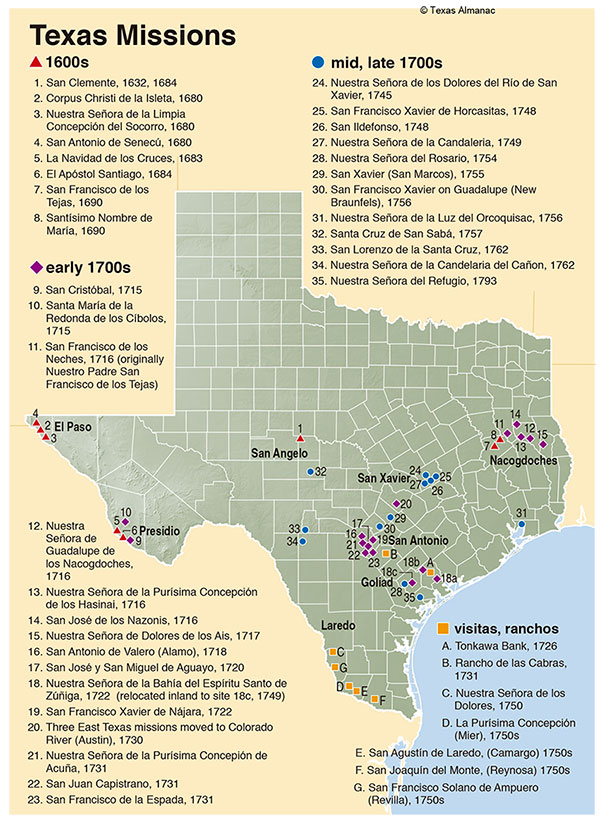We go to the middle of the 17th century. Until then, the territory that currently occupies the state of Texas did not attract the attention of the nearby Spaniards in Virreinato de Nueva España. It was a hard territory, complicated and there were the Comanche Indians who were not exactly too peaceful and collaborative. Only for these aspects that it was practically impossible to establish a colony there, and the little interest of possible settlers for the little that those lands offered.
The Spanish authorities did not decide to do anything in Texas until they realized that other European powers were beginning to show up there. The first to arrive were the French who, thanks to their journeys through Mississippi River of the French explorer René Robert Cavelier managed to find a way from French Canada to Gulf of Mexico, which united the Antillas whit this northern lands. On April 9th, 1682, he took possession of the entire Mississippi River basin and named it Louisiana in honour of the French King Sun, Louis XIV. This route not only allowed this magnificent connection but also allowed the British colonies to be circumvented, i. e. avoided.
In 1684, departed from La Rochelle (France) an expedition of 300 men and 4 ships that established the St. Louis Fort on January 1th, 1685 in the current Matagorda Bay (Texas). This news reached Nueva España that quickly set out to drive the French out of there. This mission was commissioned to Captain Alonso de León who after several trips in vain found the French fort but without them. In 1689 they found it completely destroyed and without a trace of inhabitants.
In the same area of the French fort and to secure it against new foreign incursions the Spaniards founded the mission of San Francisco de los Texas on June 1th, 1690 and sought the collaboration and friendship of the Hasinai Indians living in those lands.
There they left three priests and three soldiers who would be in charge of evangelizing and guarding these territories. In 1691 he was appointed by King the first governor of Texas, Domingo Terán, who was granted fifty soldiers and seven religious whose mission would be to found new Spanish missions.
One more mission was attempted, but it was a failure. These small enclaves were very complicated to supply and the natives were not very inclined to obey and collaborate so that 3 years later the area was abandoned and left only a small mission called San Juan Bautista in which also a presidio was built starting the old road to San Antonio.

It was not until 1715 that, thanks to the collaboration of a French merchant, Louis Juchereau de St. Denis, a great connoisseur of the tribes near Texas and Louisiana, and to the impetus of the religious orders that convinced the Virrey Duque de Linares that the plan to occupy Texas was resumed by entrusting the captain Domingo Ramón to create several missions and presidios in different parts of the region. Between 1715 and 1722 several missions were founded: San Francisco de los Neches, Nuestra Señora de la Purísima Concepción de Acuña, Nuestra Señora de Guadalupe de los Nacogdoches, San José de los Nazonis, Nuestra Señora de los Dolores de los Ais and San Miguel de Linares de los Adaes. These missions and a couple of presidios set the Texas border at river Sabina. But these missions had to be filled with people so that they could develop and become self-sufficient and not depend on external supplies, which was the cause of previous attempts to fail.
Around the middle of the 18th century, some of these missions managed to gather a certain population, between 200-500 people, who allowed to have orchards and farm animals and thus subsist. This coupled with improved pathways between these missions as well as their security against Apache and Comanche attacks through the use of flying companies allowed effective colonization of Texas.
Index of the conquest and colonization of North America
- Spanish conquest and colonization of North America.- Ponce de león and the Discovery of de Florida.
- Francisco de Garay, Expeditions along the Gulf of Mexico Coast.
- Lucas Vázquez de Ayllón, Foundation of the First Spanish Settlement in North America.
- Esteban Gómez, exploration of the entire east coast.
- Pánfilo de Narváez and Cabeza de Vaca, exploration of the Southern United States
- Nuño de Guzmán, conquistador of Nueva Galicia
- The Viceroy Mendoza and the Seven Cities of Cibola
- Hernando de Soto, the great American marathon
- Francisco Vázquez de Coronado, Arizona y Nuevo México, Texas, Kansas and Oklahoma
- Juan Rodríguez Cabrillo and the discovery of California
- Menéndez de Avilés found San Agustín of the Florida
- Juan de Oñate, the conquest of New Mexico
- The peaceful conquest
- The conquest of Texas, the Missions
- The conquest of California
- Los Caminos Reales Españoles
- The Spanish Alaska
- The Spanish Louisiana
- The loss of North America